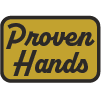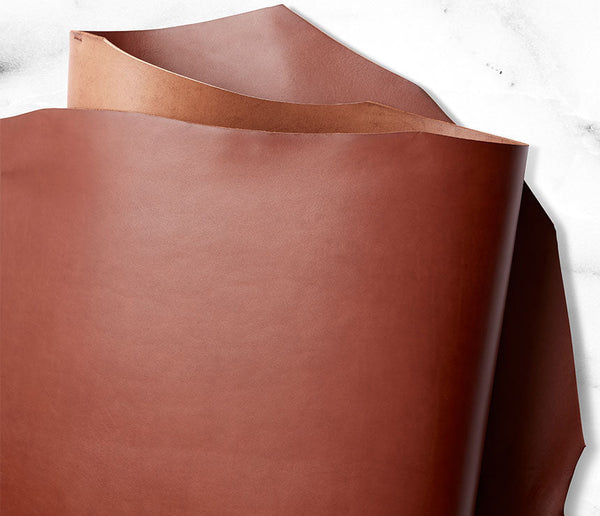The Complete Guide to Full Grain Leather | Proven Hands
Mar 15, 2025
The Complete Guide to Full Grain Leather
Full-grain leather is the toughest and longest-lasting leather you can get. It’s made from the top layer of the hide, keeping the natural grain intact.
Other types of leather get sanded down or processed to look smoother, but full-grain leather stays strong because it keeps all of its original fibers. It’s built to last, and the more you use it, the better it looks.
This isn’t the cheap, factory-made leather you see in department stores. Full-grain leather develops a patina over time, meaning it darkens and shines from wear, telling a story of every day it’s been used. The scars, wrinkles, and texture prove it’s the real deal, not some plastic-coated imitation.
How Full Grain Leather is Made
Making full-grain leather takes time. The process starts by selecting the best hides, but for full-grain leather, the entire hide qualifies—it’s not just about the back.
For belts, like the Proven Hands Full-Grain Leather Belt though, the best cuts come from the back, not the belly. Running the leather head to tail on the hide keeps the material strong and minimizes stretch.

These hides are tanned, a process that preserves the leather and prevents it from rotting. Proven Hands uses vegetable tanning, an old-school method that takes weeks instead of hours. This process uses tannins from tree bark instead of harsh chemicals. The result is leather that lasts longer, smells like real leather and doesn’t stretch as much as cheaper chrome-tanned leather.
Once tanned, the leather is conditioned with oils and waxes to keep it flexible. It’s then cut and shaped into belts, boots, or wallets. Some brands take shortcuts, using thinner cuts or adding synthetic coatings to hide imperfections.
Proven Hands doesn’t do that. Every piece of leather we use is full grain, thick and heavy, and built for durability. We even tested our belt up against a 500lb log.

What Full Grain Leather Looks Like
Full-grain leather has a natural, rugged look. Unlike corrected grain leather, which is sanded smooth, full grain leather shows natural markings. These are usually scars, bug bites, and wrinkles. These aren’t defects, they’re proof that the leather is real.

A lot of brands try to cover up imperfections by stamping fake textures onto lower-quality leather, but full-grain leather doesn’t need that. Each piece is unique, with grain patterns that show the hide’s natural character.
Full Grain Leather Upper & Its Uses
When you see the term “full grain leather upper” on boots or shoes, it means the top part of the footwear is made from full grain leather. This matters because the upper takes the most wear and tear. A full-grain leather upper won’t crack or peel like lower-grade leather.
Where Full-Grain Leather Comes From
Full-grain leather comes from cowhide. The strongest leather comes from the back and shoulder, where the fibers are dense. The belly, on the other hand, is stretchier and less durable, which is why we don’t use it for belts.

Wickett & Craig, the US Tannery we work with, has been around since 1867. It’s one of the oldest in the U.S. and has been making leather the right way for over 150 years.
While many companies outsource their leather or cut corners with cheap tanning methods, Proven Hands keeps it American-made with real, full-grain leather.
Types of Full Grain Leather Finishes
Pebbled Leather
Pebbled leather has a textured surface created by tumbling the hide. This process doesn’t weaken the leather, it just changes the look. It gives it a more rugged or dressy appearance, depending on how it’s finished.
Burnished Leather
Burnished leather is polished to bring out darker, richer tones. This gives it a slightly worn-in look right from the start.
Oiled Full-Grain Leather
Oiled leather is treated with natural oils to make it more water-resistant and flexible. It’s often used in work boots because it handles moisture better than untreated leather.
Tumbled Full Grain Leather
Tumbled leather is softened through a tumbling process, making it more flexible without losing durability.
Leather Thickness & Durability
Full-grain leather is thicker than other types of leather because it isn’t sanded down. It typically ranges from 3-5mm in thickness, making it strong enough for heavy-duty use.
Thinner leather stretches and wears out faster. This is why Proven Hands belts are cut thick. They’re made to be used daily.
How to Maintain Full Grain Leather
Taking care of full-grain leather is simple. Wipe it down with a damp cloth when it gets dirty. Use a leather conditioner occasionally to keep it from drying out. Avoid storing it in extreme heat or direct sunlight for long periods.
How to Protect & Waterproof Full Grain Leather
While full-grain leather naturally resists moisture, it isn’t 100% waterproof. To protect it, apply a leather wax or oil. Beeswax-based conditioners work best because they add water resistance without making the leather too soft. Proven Hands burnishes its belt edges with natural beeswax from U.S. bees for added protection.
How Long Does Full Grain Leather Last?
If cared for properly, full-grain leather can last decades. Cheap leather belts or wallets fall apart within a few years, but a well-made full-grain leather product only gets better with time.
Our handmade leather belts are designed to be heirloom quality, meant to last generations.
Full Grain Leather vs. Other Leather Types
Full Grain vs. Corrected Leather
Corrected leather is sanded to remove imperfections, making it look more uniform but also weaker. Full-grain leather is unaltered, meaning it stays tougher.
Full Grain vs. Bonded Leather
Bonded leather is made from leftover leather scraps glued together. It’s the weakest type of leather and won’t hold up like full grain.
Full Grain vs. Genuine Leather
“Genuine leather” sounds high-end, but it’s actually a lower-quality leather made from split layers of hide. It’s better than bonded leather but not as durable as full grain.
Suede & Nubuck
Suede and nubuck are both made from the underside of the hide. Suede is soft but weaker than full-grain leather, while nubuck is sanded for a velvety texture. Both look nice but don’t have the same durability.
Proven Hands: Handmade Full Grain Leather Belt Coming March 17th 2025 at 5pm CST
The Proven Hands handmade leather belt is built with thick, vegetable-tanned leather, cut from the strongest part of the hide. The edges are burnished with natural beeswax for added water resistance, and the belt holes are punched in an oblong shape to keep them from stretching over time.

Most companies cut corners, using chrome-tanned leather, synthetic coatings, or glued layers that fall apart. Proven Hands refuses to do that.
Every belt is handmade in the USA using traditional leatherworking techniques. It’s not just another product, it’s something you can wear for decades.

If you're looking for a durable leather belt that holds up to hard work, keeps its shape, and looks better with age, this is it. Stay tuned for the upcoming launch on March 17th at 5pm. Follow us on Instagram or sign-up for our newsletter.

Sign up today because the next launch will be a pre-order only and will be a limited list. Only 100 belts are being made, be one of the first to own a Proven Hands 100% Made in USA Full-Grain Leather Belt.




